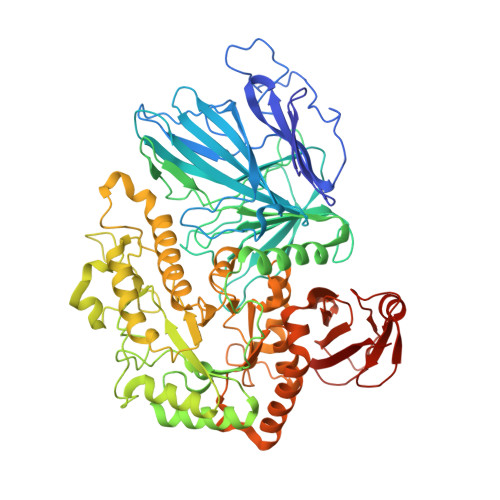Crystal Structure of Alpha-Galactosidase from Lactobacillus Acidophilus Ncfm: Insight Into Tetramer Formation and Substrate Binding.
Fredslund, F., Abou Hachem, M., Jonsgaard Larsen, R., Gerd Sorensen, P., Coutinho, P.M., Lo Leggio, L., Svensson, B.(2011) J Mol Biol 412: 466
- PubMed: 21827767
- DOI: https://doi.org/10.1016/j.jmb.2011.07.057
- Primary Citation of Related Structures:
2XN0, 2XN1, 2XN2 - PubMed Abstract:
Lactobacillus acidophilus NCFM is a probiotic bacterium known for its beneficial effects on human health. The importance of α-galactosidases (α-Gals) for growth of probiotic organisms on oligosaccharides of the raffinose family present in many foods is increasingly recognized. Here, the crystal structure of α-Gal from L. acidophilus NCFM (LaMel36A) of glycoside hydrolase (GH) family 36 (GH36) is determined by single-wavelength anomalous dispersion. In addition, a 1.58-Å-resolution crystallographic complex with α-d-galactose at substrate binding subsite -1 was determined. LaMel36A has a large N-terminal twisted β-sandwich domain, connected by a long α-helix to the catalytic (β/α)(8)-barrel domain, and a C-terminal β-sheet domain. Four identical monomers form a tightly packed tetramer where three monomers contribute to the structural integrity of the active site in each monomer. Structural comparison of LaMel36A with the monomeric Thermotoga maritima α-Gal (TmGal36A) reveals that O2 of α-d-galactose in LaMel36A interacts with a backbone nitrogen in a glycine-rich loop of the catalytic domain, whereas the corresponding atom in TmGal36A is from a tryptophan side chain belonging to the N-terminal domain. Thus, two distinctly different structural motifs participate in substrate recognition. The tetrameric LaMel36A furthermore has a much deeper active site than the monomeric TmGal36A, which possibly modulates substrate specificity. Sequence analysis of GH36, inspired by the observed structural differences, results in four distinct subgroups having clearly different active-site sequence motifs. This novel subdivision incorporates functional and architectural features and may aid further biochemical and structural analyses within GH36.
Organizational Affiliation:
Department of Systems Biology, Enzyme and Protein Chemistry, Technical University of Denmark, Søltofts Plads, Building 224, DK-2800 Kongens Lyngby, Denmark.
















